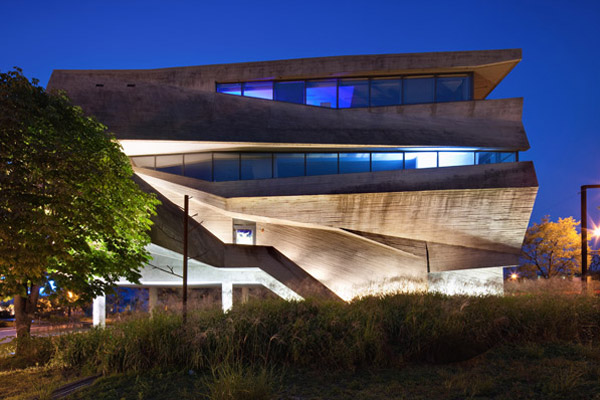The First International ‘Light Asia’ Festival was held in Paju, South Korea this year, bringing a wealth of innovation, technology and lighting design to a previously dim city.

December 16th, 2013
Rather than holding the inaugural ‘Light Asia’ Festival in a brightly lit venue, the small town of Paju (known as ‘Book City’ for its strong publishing industry, and notoriously dark after nighfall) was chosen to host the event, with the organisers reasoning that the stunning lighting displays would appear even more striking against its dusky backdrop.
The festival was organised in two parts: Lighting Design Workshops from 27-31 August 2013, and a public exhibition of the outcome of the workshops from September 1 until October 6 2013.
International in scope, participants in the festival included invited included:
Each invitee became the leader of a workshop group of eight, making a total of 64 participants in all. They came from departments at local colleges and universities of Architecture, Landscaping, Interior Design and Industrial design.
Mark Elliott’s group were asked to look at designs for Salim Alice’s House, a publisher who specialised in children’s books. The building’s design was inspired by the Alice In Wonderland story. Participants under Mark’s direction were required to prepare sketches to identify distinctive architectural forms which resulted in the building being immersed in colour schemes of red and white. Dynamic elements were provided by a scrolling LED sign board located along the ribbon window openings at podium level to create an impressive mood fantasy.
The concrete buildings occupied by Tae Hak Publications presented some interesting challenges for Mirjam Roos and her group. Inspiration was derived from A Midsummer Nights Dream. 25 windows were selected to randomly display colour-changing light from the interior to match the plot of the original story. The right hand side building corner façade was covered thickly with ivy. LED sparkle sources were used to highlight the texture of the leaves creating an overall fantasy atmosphere.
Tim Carr’s group was allotted the Jisik Sanup Buildings; one of which represented a reader and the other the book. Contrasting colour tones of warm white and blue were used to represent an association between knowledge and wisdom.
The Borim Press Building specialises in children’s books. Andrew Jaques’ group adopted a lighting approach that embraced playfulness and amusement. The building is an irregular shaped mass complete with translucent acrylic glazing and steel mesh. Linear RGB colour-changing luminaires were mounted on the interior floors along the façade to back light the acrylic glazing and mimic the natural movement of reeds, a well recognised local motif.
David Bird’s group was assigned the Dong Hwa press buildings featuring a façade made of a concrete mass covered with rusted mesh wires over a steel frame. Micro LED sources revealed the varying textures. The two buildings were connected through a central glass foyer lit from within with controlled feature lighting. While the effect during daylight hours was somewhat rigid and boxed it was transformed as darkness fell into shimmering light points offset from behind the linear front façade.
The Saeng Neung press building appears to be assembled from Lego bricks. Donn Salisbury’s group was intent on accentuating the spiral formation of the exterior balcony from ground level up to the top floor. Linear Colour changing LED luminaires were mounted along the floors to up-light the underside of the balconies. This elegant use of colour and colour change beautifully accentuated the architectural form of the building.
The impressive concrete surfaces and feature window openings of the Maroniebooks building (top picture) presented Horatio Burton and his team with some interesting challenges. Intent on revealing the delicate play of concrete surfaces as folds of paper an interior glow was created with white light and openings were back lit with colour.
“For a first time event it had big aspirations, through a lot of hard work and passion for its success the event sets a high bar for the future” said team leader Mark Elliott of PointOfView Sydney, Australia.
Holding a lighting festival in a location where there had previously been almost no artificial light meant that the festival’s efforts and outcomes were very much appreciated. Because the lighting designs presented did not have to compete with existing installations executions did not have to be overtly flamboyant to receive attention. They matched well with the ethos of Book City and were seen by the public and officials alike to support the philosophy upon which the town was founded.
KKDC in collaboration with Bitzro & Partners is already reviewing and planning for Light Asia Festival 2014 and beyond.
KKDC
kkdc.com.au
Bitzro & Partners
bitzro.co.kr
INDESIGN is on instagram
Follow @indesignlive
A searchable and comprehensive guide for specifying leading products and their suppliers
Keep up to date with the latest and greatest from our industry BFF's!

Welcomed to the Australian design scene in 2024, Kokuyo is set to redefine collaboration, bringing its unique blend of colour and function to individuals and corporations, designed to be used Any Way!

For Aidan Mawhinney, the secret ingredient to Living Edge’s success “comes down to people, product and place.” As the brand celebrates a significant 25-year milestone, it’s that commitment to authentic, sustainable design – and the people behind it all – that continues to anchor its legacy.

We’ve taken you on the architectural walk-through of Capella Sydney, now Gillian Serisier goes inside this prominent hotel to share the interior story – one of timeless elegance and artful vision.
Is aversion to risk stifling our creative culture? Andrew Mackenzie questions why design competitions are so undervalued in Australia.
The internet never sleeps! Here's the stuff you might have missed

With Steelcase having reopened its refreshed WorkLife Showroom in Singapore this year, we spoke to Navedita Shergill about some key workplace macro shifts identified in their research.

Pier Pavilion by Besley & Spresser provides a refreshing, architecturally thoughtful and versatile public space by the water at Barangaroo.